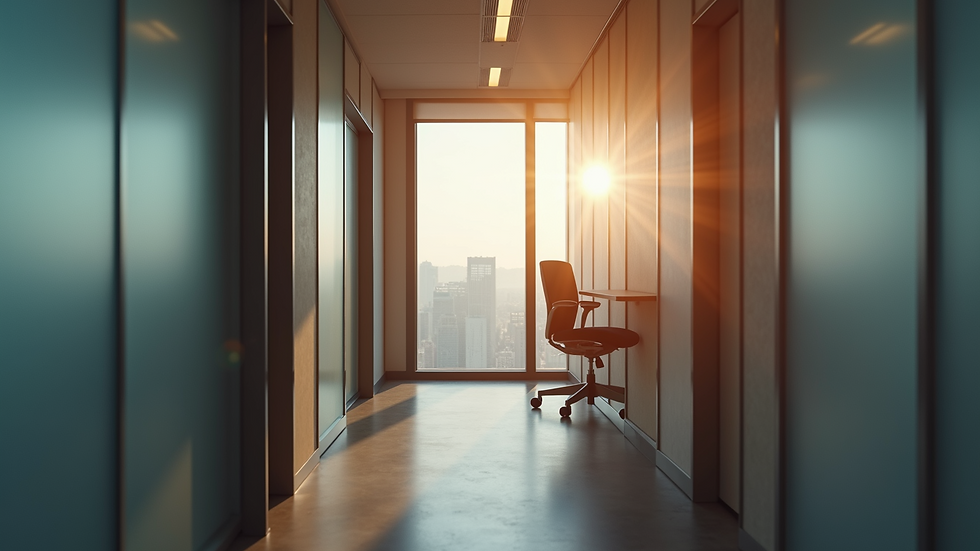Innovative Office Cubicle Designs for Modern Workspaces
- info1163643
- Aug 27
- 4 min read
Creating a productive workspace requires more than just a desk and chair. The design of office cubicles plays a crucial role in shaping how people work and interact. I explore innovative office cubicle designs that meet the needs of today’s work environments. These designs focus on flexibility, comfort, and technology integration to support various work styles.
Key Features of Modern Office Cubicle Designs
Modern office cubicle designs prioritize functionality and adaptability. They move away from the traditional closed boxes to open, inviting spaces that encourage collaboration while maintaining privacy.
Modular Components: Use modular panels and furniture that can be rearranged easily. This allows quick adaptation to changing team sizes or project needs.
Ergonomic Elements: Include adjustable desks, supportive chairs, and proper lighting to reduce strain and improve comfort.
Acoustic Solutions: Integrate sound-absorbing materials to minimize distractions and create a quieter environment.
Technology Integration: Provide built-in power outlets, USB ports, and cable management systems to keep devices charged and organized.
These features combine to create workspaces that support focus and teamwork equally.

Exploring Office Cubicle Designs That Enhance Productivity
I focus on designs that improve workflow and employee satisfaction. Here are some practical examples:
Open Cubicle Layouts
These use low partitions to maintain a sense of openness. They encourage communication while offering personal space. Adding plants or small dividers can enhance privacy without closing off the area.
Private Pods
For tasks requiring deep focus, private pods offer enclosed spaces with soundproofing. These pods often include adjustable lighting and ventilation to create a comfortable micro-environment.
Collaborative Clusters
Group cubicles in clusters to facilitate teamwork. Shared tables or whiteboards between cubicles help teams brainstorm and share ideas easily.
Standing Desk Cubicles
Incorporate standing desks to promote movement and reduce sedentary behavior. Adjustable desks allow users to switch between sitting and standing throughout the day.
Tech-Enabled Cubicles
Equip cubicles with smart technology such as wireless charging pads, integrated monitors, and video conferencing tools. This setup supports remote collaboration and multitasking.
Each design addresses specific work needs and can be customized to fit different office sizes and budgets.

Materials and Finishes for Contemporary Cubicles
Choosing the right materials impacts both aesthetics and functionality. I recommend materials that are durable, easy to maintain, and visually appealing.
Glass Panels: Use frosted or clear glass to create a sense of openness while maintaining privacy. Glass also allows natural light to flow through the workspace.
Fabric Panels: Acoustic fabric panels reduce noise and add texture. They come in various colors to match branding or interior themes.
Wood Finishes: Wood or wood-look laminates add warmth and a natural feel. They work well in offices aiming for a more traditional or upscale look.
Metal Frames: Metal provides structural strength and a modern industrial appearance. Powder-coated finishes resist scratches and wear.
Combining these materials thoughtfully can create a balanced and inviting workspace.

Customization and Personalization Options
Allowing employees to personalize their cubicles boosts morale and comfort. I suggest these options:
Adjustable Shelving and Storage: Provide flexible storage solutions that users can arrange to suit their needs.
Color Choices: Offer panels and accessories in different colors to reflect individual preferences or company branding.
Lighting Controls: Enable users to adjust task lighting for optimal visibility and comfort.
Decorative Elements: Encourage adding plants, artwork, or personal items to make the space feel welcoming.
Customization supports diverse work styles and helps employees feel more connected to their workspace.
Practical Tips for Selecting Office Cubicle Designs
When choosing office cubicle designs, consider these factors:
Space Utilization: Measure available space carefully. Opt for designs that maximize efficiency without overcrowding.
Budget Constraints: Balance cost with quality and features. Pre-owned options can offer savings without sacrificing functionality.
Employee Needs: Survey users to understand their preferences and work habits. Tailor designs to support their daily tasks.
Future Growth: Select modular systems that can expand or reconfigure as the company grows or changes.
Delivery and Installation: Choose suppliers that offer local delivery and professional installation to minimize downtime.
These steps ensure the investment in office cubicles delivers long-term value.
I recommend exploring office cubicles from trusted providers who offer a wide selection and convenient services like local delivery and in-store pickup. This approach simplifies the process of creating a functional and comfortable workspace.
Enhancing Workspace Comfort and Efficiency
Innovative office cubicle designs contribute to a healthier and more efficient work environment. Focus on:
Ergonomics: Prioritize adjustable furniture to reduce physical strain.
Lighting: Use natural light where possible and supplement with adjustable task lighting.
Air Quality: Incorporate ventilation and air-purifying plants.
Noise Control: Use acoustic panels and white noise machines to reduce distractions.
Technology Access: Ensure easy access to power and data connections.
Implementing these elements improves employee well-being and productivity.
By applying these principles and exploring innovative office cubicle designs, you can create workspaces that meet modern demands. Focus on flexibility, comfort, and technology to support diverse work styles and enhance overall efficiency.



Comments